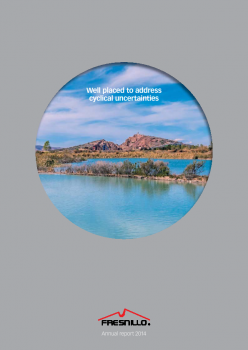
COUNTING TO 10
The FTSE 100’s best annual reports are evaluated at the annual “How Does it Stack Up? event held by Radley Yeldar. Brittany Golob reports from the conference and awards presentation
"We're not there yet," says Brett Simnett, investor engagement director at Radley Yeldar in regards to best practice in corporate reporting. The last few years have forced a mountain of changes upon corporate reporting. Communicators are left trying to meet the demands of the regulators, investors and other stakeholders, while simultaneously trying to make sense of these changes. Their work, though exemplary, has yet to exemplfiy best practice in strategic reporting. Though progress has been made, Simnett says. "Reporting is still getting longer instead of getting shorter. What we want to see more of is putting the business model at the heart of reporting, letting that business model identify the relationships and resources that are critical to your business and using that business model to inform the content and structure of your report," he adds.
“The strategic report is an enormous opportunity for companies to get away from the things they have to report and focus on the things the directors thing is actually important”
Radley Yeldar has been examining and evaluating the annual reports of the FTSE 100 for the past 10 years. Last month, the agency announced the top 10 strategic and online reports at the annual How Does it Stack Up? event and conference. The awards were complemented by a conference discussing the challenges investor relations is facing, the ways in which corporate reporting is changing and the impact regulatory shifts has had on reporting.
What How Does it Stack Up? made clear is there are countless perceptions of the role of corporate reporting and the strategy with which to create an annual report. Martin Blaxall, director of corporate reporting and communications at AstraZeneca, said, “We see it as a legal document because it’s a very litigious sector. But we do see it as quite a significant communications document.” The pharma company’s perspective is not unique to the sector as most view the annual report as a legal requirement that provides an opportunity to communicate. “Keep your friends close but your lawyers closer,” says Blaxall, as his team includes an in- house lawyer, streamlining the approval process.
Yet, the annual report has to be, above all else, true to the buinsess' prupose and strategy. Brigette Jespersen Skade of Berendsen,  a European textile company, looks at the opportunities the annual report offerst to explain a complex business to investors, the media and potential clients, but to also make the internal audience proud of and kept abreast of the business' goals. Anthony Hamilton, investor relations executive at Vodafone, says aspects of the telecoms buinsess are complex and decisions don't always impact the bottom line. He sees the annual report as a communications tool. It’s a tick-box exercise, he says, in meeting regulations, but it can’t just be launched into cyberspace. Like any piece of communications, the report must be part of a wider campaign. “We don’t just produce the report. You then have to make the effort to push it out to people,” Hamilton says. This year, Vodafone complemented the report with a series of videos about the history and culture of the company.
a European textile company, looks at the opportunities the annual report offerst to explain a complex business to investors, the media and potential clients, but to also make the internal audience proud of and kept abreast of the business' goals. Anthony Hamilton, investor relations executive at Vodafone, says aspects of the telecoms buinsess are complex and decisions don't always impact the bottom line. He sees the annual report as a communications tool. It’s a tick-box exercise, he says, in meeting regulations, but it can’t just be launched into cyberspace. Like any piece of communications, the report must be part of a wider campaign. “We don’t just produce the report. You then have to make the effort to push it out to people,” Hamilton says. This year, Vodafone complemented the report with a series of videos about the history and culture of the company.
But regulators, however much they give in terms of guidance, have changed the game since 2010. New regulations have forced corporate reporters to work toward a strategic report that includes not only finances but the company’s positioning statement. This has spawned a few schools of thought: one is the narrative report, that tells a story about the company through its objectives, integrated reporting, which seeks to incorporate CSR reporting and narrative reporting into one single annual report, and the varying degrees of online reporting which vary company to company.
With this mélange of ideology swirling about, Simnett’s comments about the lack of a consistent standard of best practice are unsurprising. Yet, the annual report is still a communications document. Simnett says, “It was valuable to hear from the actual content creators and the value they put on the annual reports outside of the document, about how they speak to their employees.”
 The regulators and overseers of investor relations share a similar goal: to make something required into something useful to multiple audiences. That’s at the heart of the integrated and narrative reporting movements. Jonathan Labrey, chief strategy officer at the International Integrated Reporting Council says the integrated report will help make communications key to reputation management. Peter Swabey, policy & research director at the Institute of Chartered Secretaries and Administrators says risk management is a process that can be effectively described in the annual report, “The importance of risk in reporting integrates all those factors to give a comprehensive overview of the way these companies are managed.”
The regulators and overseers of investor relations share a similar goal: to make something required into something useful to multiple audiences. That’s at the heart of the integrated and narrative reporting movements. Jonathan Labrey, chief strategy officer at the International Integrated Reporting Council says the integrated report will help make communications key to reputation management. Peter Swabey, policy & research director at the Institute of Chartered Secretaries and Administrators says risk management is a process that can be effectively described in the annual report, “The importance of risk in reporting integrates all those factors to give a comprehensive overview of the way these companies are managed.”
He adds that the annual report is still thought of as a printed document, a mindset that should change as digital plays a larger role in corporate reporting. “The strategic report is an enormous opportunity for companies to get away from the things they have to report and focus on the things the directors thing is actually important,” Swabey adds. Most companies are taking advantage of the opportunities offered by digital reporting. Some, like Vodafone, are integrating video seamlessly into the online experience, others create interactive microsites housing their annual reports to allow for easier access to key facts and information. Still others, like Legal & General, which leads this sub-category, have pursued a full-HTML option which provides full accessibility to disabled people and those with special needs.
The conference also featured a session with investors and analysts who offered their advice and perspectives. They said corporate reporting communicators should know who their audience is, meet with the relevant people and ensure their reports communicate  the business’ strategy and positioning.
the business’ strategy and positioning.
For many of these reasons, Radley Yeldar has evaluated annual reports for the past 10 years. The How Does it Stack Up? ranking documents the most effective annual reports in terms of communications. Reports in the two categories – strategic and online reporting – are judged separately. A company with an excellent printed report and sub-par online report can still rank highly in strategic reporting, and vice versa. The reports are judged on criteria about the content, design and format of online and printed reports.
The top three in the online category were BG Group, Land Securities and BT. Radley Yeldar praised BG Group’s structure, consistent mobile experience and user journey and said Land Securities excelled in terms of its narrative, design and intuitive navigation. BT was, “Very well considered for the online space,” according to one of the Radley Yeldar evaluators. It is a good example, they say, of digital communications even outside of the annual reporting context. This is BT’s third year in the top 10.
Simnett says, however, “There’s been a convergence to the middle. Lots of reporters are doing ‘reporting lite.’ We still haven’t gotten to the point in online reporting where it’s become a lot better. We’ve hit a plateau.” All, he says, though, adapt the printed report to the online space “Incredibly well.”
On the strategic reporting side, some veterans of How Does it Stack Up? are rated highly again this year. The evaluators chose a solid group of four reports to lead the rest. AstraZeneca, Simnett says, just missed out on the 3rd-place spot and is a consistent leader in corporate reporting. But those who made the top three were of a high standard. Vodafone’s focus on its 30th anniversary allowed its online and printed reports to focus on the business’ story. Land Securities featured the best governance section and  excelled in the risk management and assessment section. “Land Securities has been one of our top reporters for over a decade,” Simnett says. “They’ve always been on the list. The whole narrative links together in a coherent flow, their risk reputation is exemplary and discussions of principle and emerging risks and governance make it one of the most informative and engaging in the FTSE 100.
excelled in the risk management and assessment section. “Land Securities has been one of our top reporters for over a decade,” Simnett says. “They’ve always been on the list. The whole narrative links together in a coherent flow, their risk reputation is exemplary and discussions of principle and emerging risks and governance make it one of the most informative and engaging in the FTSE 100.
Yet the clear winner, for the second year running, was Fresnillo, which had few weaknesses. “There is so much to admire in this report,” Simnett says. It tells a coherent story and includes top-notch content from the CEO’s report through to the sustainability section, information about KPIs and its future-looking tone. Though there are consistent guiding lights, corporate reporting is still changing. “The FTSE 100 is not a good example of integrated reporting. Until they put the business model at the heart of reporting, that will still be a challenge,” Simnett says. The future is theirs for the taking.
This feature was supported by Radley Yeldar. The top 10 winners of How Does it Stack Up? were announced on 8 July. 



